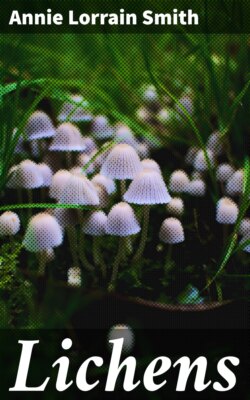Читать книгу Lichens - Annie Lorrain Smith - Страница 37
На сайте Литреса книга снята с продажи.
C. Culture of Hyphae without Gonidia
ОглавлениеArtificial cultures had demonstrated the germination of lichen spores, with the formation of hyphae, and from synthetic cultures of fungus and alga complete lichen plants had been produced. To Möller[269] we owe the first cultures of a thalline body from the fungus alone, both from spermatia and from ascospores. The germination of the spermatia has a direct bearing on their function as spores or as sexual organs and is described in a later chapter.
The ascospores of Lecanora subfusca were caught in a drop of water on a slide as they were ejaculated from the ascus, and, on the following day, a very fine germinating tube was seen to have pierced the exospore. The hypha became slightly thicker, and branching began on the third day. If in water alone the culture soon died off, but in a nutrient solution growth slowly continued. The hyphae branched out in all directions from the spore as a centre and formed an orbicular expansion which in fourteen days had reached a size of ·1 mm. in diameter. After three weeks’ growth it was large enough to be visible without a lens; the mycelial threads were more crowded, and certain terminal hyphae had branched upwards in an aerial tuft, this development taking place from the centre outwards. Möller marked this stage as the transition from a mere protothallus to a thallus formation. In three months a diameter of 1·5-2 mm. was reached; a transverse section gave a thickness of ·86 mm. and from the under side loose hyphae branched downwards and attached the thallus, when it had been transferred to a solid substratum such as cork. Above these rhizoidal hyphae, a stratum of rather loose mycelium represented the medulla, and, surmounting that, a cortical layer in which the hyphae were very closely compacted. Delicate terminal branches rose into the air over the whole surface, very similar in character to hypothallic hyphae at the margin of the thallus.
Lecanora subfusca has a rather small simple spore; it emitted germinating tubes from each end, and a septum across the middle of the spore appeared after germination had taken place. Another experiment was with a much larger muriform spore measuring 80 µ in length and 20 µ in thickness. On germination about 20 tubes were formed, some of them rising into the air at once, the others encircling the spore, so that the thallus took form immediately; growth in this case also was centrifugal. In three months a diameter of 6 mm. was reached with a thickness of 1 to 2 mm. and showing a differentiation into medulla and cortex. The hyphae did not increase in width, but frequently globose or ovate swellings arose in or at the ends, a character which recurs in the natural growth of hyphae both of lichens and of Ascomycetes. These swellings depend on the nutrition.
Pertusaria communis possesses a very large simple spore, but it is multinucleate and germinates with about 100 tubes which reach their ultimate width of 3 to 4 µ before they emerge from the exospore. The hyphae encircle the spore, and an opaque thalline growth is quickly formed from which rise terminal hyphal branches. In ten weeks the differentiation into medulla and cortex was reached, and in five months the hyphal thallus measured 4 mm. in diameter and 1 to 2 mm. in thickness.
Möller instituted a comparison between the thalli he obtained from the spores and those from the spermatia of another crustaceous lichen, Buellia punctiformis (B. myriocarpa). After germination had taken place the hyphae from the spermatia grew at first more quickly than those from the ascospores, but as soon as thallus formation began the latter caught up and, in eight weeks, both thalli were of equal size.
Another comparative culture with the spermatia and ascospores of Opegrapha subsiderella gave similar results: the spores of that species are elongate-fusiform and 6-to 8-septate; germination took place from the end cells in two to three days after sowing. The germinating hyphae corresponded exactly with those from the spermatia and growth was equally slow in both. The middle cells of the spores may also produce germinating tubes, but never more than about five were observed from any one spore. A browning of the cortical layer was especially apparent in the hyphal culture from another lichen, Graphis scripta: a clear brown colour gradually changing to black appeared about the same period in all the cultures.
The hyphae from the spores of Arthonia developed quickest of all: the hyphae were very slender, but in three to four months the growth had reached a diameter of 8 mm. In this plant there was the usual outgrowth of delicate hyphae from the surface; no definite cortical layer appeared, but only a very narrow line of more closely interwoven somewhat darker hyphae. Frequently, from the surface of the original thallus, excrescences arose which were the beginnings of further thalli.
Tobler[270] experimenting with Xanthoria parietina gained very similar results. The spores were grown in malt extract for ten days, then transferred to gelatine. In three to five weeks there was formed an orbicular mycelial felt about 3 mm. in diameter and 2 mm. thick. The mycelium was frequently brownish even in healthy cultures, but the aerial hyphae which, at first, rose above the surface were always colourless. After these latter disappeared a distinct brownish tinge of the thallus was visible. In seven months it had increased in size to 15 mm. in length, 7 mm. in width and 3 mm. thick with a differentiation into three layers: a lower rather dense tissue representing the pith, above that a layer of loose hyphae where the gonidial zone would normally find place, and above that a second compact tissue, or outer cortex, from which arose the aerial hyphae. The culture could not be prolonged more than eight months.
